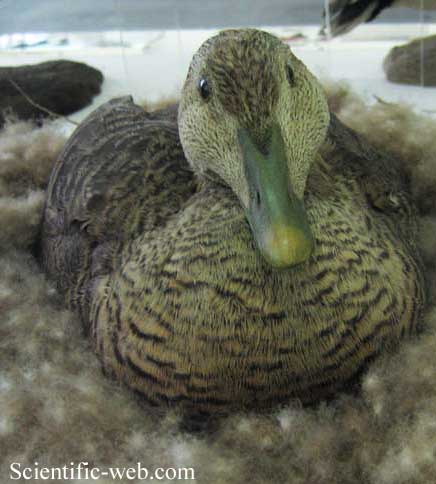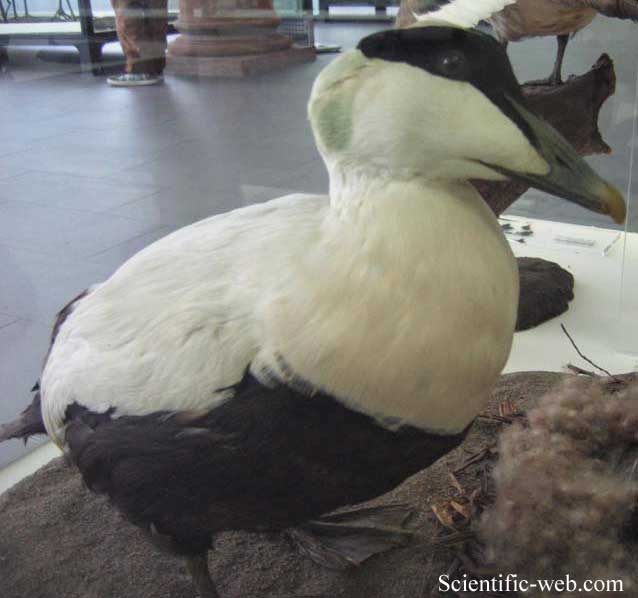
Somateria mollissima, Photo: Michael Lahanas
Superregnum: Eukaryota
Cladus: Unikonta
Cladus: Opisthokonta
Cladus: Holozoa
Regnum: Animalia
Subregnum: Eumetazoa
Cladus: Bilateria
Cladus: Nephrozoa
Superphylum: Deuterostomia
Phylum: Chordata
Subphylum: Vertebrata
Infraphylum: Gnathostomata
Megaclassis: Osteichthyes
Cladus: Sarcopterygii
Cladus: Rhipidistia
Cladus: Tetrapodomorpha
Cladus: Eotetrapodiformes
Cladus: Elpistostegalia
Superclassis: Tetrapoda
Cladus: Reptiliomorpha
Cladus: Amniota
Classis: Reptilia
Cladus: Eureptilia
Cladus: Romeriida
Subclassis: Diapsida
Cladus: Sauria
Infraclassis: Archosauromorpha
Cladus: Crurotarsi
Divisio: Archosauria
Cladus: Avemetatarsalia
Cladus: Ornithodira
Subtaxon: Dinosauromorpha
Cladus: Dinosauriformes
Cladus: Dracohors
Cladus: Dinosauria
Ordo: Saurischia
Cladus: Eusaurischia
Subordo: Theropoda
Cladus: Neotheropoda
Cladus: Averostra
Cladus: Tetanurae
Cladus: Avetheropoda
Cladus: Coelurosauria
Cladus: Tyrannoraptora
Cladus: Maniraptoromorpha
Cladus: Maniraptoriformes
Cladus: Maniraptora
Cladus: Pennaraptora
Cladus: Paraves
Cladus: Eumaniraptora
Cladus: Avialae
Infraclassis: Aves
Cladus: Euavialae
Cladus: Avebrevicauda
Cladus: Pygostylia
Cladus: Ornithothoraces
Cladus: Ornithuromorpha
Cladus: Carinatae
Parvclassis: Neornithes
Cohors: Neognathae
Cladus: Pangalloanserae
Cladus: Galloanseres
Ordo: Anseriformes
Familia: Anatidae
Subfamilia: Merginae
Genus: Somateria
Species: Somateria mollissima
Subspecies: S. m. borealis – S. m. dresseri – S. m. faeroeensis – S. m. mollissima – S. m. sedentaria – S. m. v-nigrum
Name
Somateria mollissima (Linnaeus, 1758)
Synonyms
Anas mollissima (protonym)

Somateria mollissima, Photo: Michael Lahanas
References
Linnaeus, C. 1758. Systema Naturae per regna tria naturae, secundum classes, ordines, genera, species, cum characteribus, differentiis, synonymis, locis. Editio Decima, Reformata. Tomus I. Holmiæ (Stockholm): impensis direct. Laurentii Salvii. 824 pp. DOI: 10.5962/bhl.title.542 BHL p. 124 BHL Reference page.
Vernacular names
asturianu: Coríu Pina
беларуская: Звычайная гага
български: Обикновена гага
brezhoneg: Eider-dum
català: Èider
čeština: Kajka mořská
Cymraeg: Hwyaden fwythblu
dansk: Ederfugl
Deutsch: Eiderente
Ελληνικά: Πουπουλόπαπια
English: Common Eider
Esperanto: Komuna molanaso
español: Eider común
eesti: Hahk
euskara: Eider arrunt
suomi: Haahka
føroyskt: Æða
Nordfriisk: Eidergus
français: Eider à duvet
Frysk: Eider
Gaeilge: Colc
Gàidhlig: Colc
galego: Éider
Gaelg: Laagh Loghlinagh
עברית: אדרית שחורת כיפה
hrvatski: Gavka
magyar: Pehelyréce
Iñupiatun: Amauligruaq
íslenska: Æðarfugl
italiano: Edredone
ᐃᓄᒃᑎᑐᑦ/inuktitut: Amaulik
日本語: ホンケワタガモ
kalaallisut: Miteq siorartooq
kernowek: Hos eyder
lietuvių: Paprastoji gaga
latviešu: Parastā pūkpīle
Nedersaksies: Eiderente
Nederlands: Eidereend
norsk nynorsk: Ærfugl
norsk: Ærfugl
Diné bizaad: Hakʼaz naalʼeełí
polski: Edredon
português: Eider-edredão
rumantsch: Anda loma
русский: Гага
саха тыла: Улахан турукаан
Scots: Dunter
davvisámegiella: Hávda
srpskohrvatski / српскохрватски: Gavka
slovenčina: Kajka morská
slovenščina: Navadna gaga
shqip: Pata e detit
српски / srpski: Gavka - Гавка
svenska: Ejder
Türkçe: Pufla
українська: Гага
Tiếng Việt: Vịt nhung thường
中文: 欧绒鸭
The common eider (pronounced /ˈaɪ.dər/) (Somateria mollissima), also called St. Cuthbert's duck or Cuddy's duck, is a large (50–71 cm or 20–28 in in body length) sea-duck that is distributed over the northern coasts of Europe, North America and eastern Siberia. It breeds in Arctic and some northern temperate regions, but winters somewhat farther south in temperate zones, when it can form large flocks on coastal waters. It can fly at speeds up to 113 km/h (70 mph).[2]
The eider's nest is built close to the sea and is lined with eiderdown, plucked from the female's breast. This soft and warm lining has long been harvested for filling pillows and quilts, but in more recent years has been largely replaced by down from domestic farm-geese and synthetic alternatives. Although eiderdown pillows or quilts are now a rarity, eiderdown harvesting continues and is sustainable, as it can be done after the ducklings leave the nest with no harm to the birds.
Taxonomy
The common eider was formally named by the Swedish naturalist Carl Linnaeus in 1758 in the tenth edition of his Systema Naturae. He placed it with all the other ducks in the genus Anas and coined the binomial name Anas mollissima.[3] It is now placed with two other species in the genus Somateria that was introduced in 1819 by the English zoologist William Leach.[4][5] The genus name is derived from Ancient Greek σῶμα : sōma "body" (stem somat-) and ἔριον : erion "wool". The specific mollissimus is Latin meaning "very soft". Both parts of the name refer to its down feathers.[6]
Six subspecies are recognised:[5]
S. m. v-nigrum Bonaparte & Gray, GR, 1855 – breeds in northeast Asia and Alaska; winters in the Bering Sea and the Aleutian Islands
S. m. borealis (Brehm, CL, 1824) – breeds in northeast Canada, Greenland and Iceland; winters in the north Atlantic
S. m. sedentaria Snyder, 1941 – breeds in Hudson Bay and James Bay (Canada)
S. m. dresseri Sharpe, 1871 – breeds in southeast Canada and northeast USA; winters around northwest Atlantic coasts
S. m. faeroeensis Brehm, CL, 1831 – Faroe Islands
S. m. mollissima (Linnaeus, 1758) – breeds in northwest Eurasia; winters in northwest and central Europe
Description
A common eider skull
Egg, Collection Museum Wiesbaden
The common eider is both the largest of the four eider species and the largest duck found in Europe, and is exceeded in North America only by smatterings of the Muscovy duck, which only reaches North America in a wild state in southernmost Texas (and arguably south Florida where feral but non-native populations reside). It measures 50 to 71 cm (19+1⁄2 to 28 in) in length, weighs 0.81 to 3.04 kg (1 lb 12+1⁄2 oz to 6 lb 11 oz) and spans 80–110 cm (31–43 in) across the wings.[7][8] The average weight of 22 males in the North Atlantic was 2.21 kg (4 lb 14 oz) while 32 females weighed an average of 1.92 kg (4 lb 3+1⁄2 oz).[9] It is characterized by its bulky shape and large, wedge-shaped bill. The male is unmistakable, with its black and white plumage and green nape. The female is a brown bird, but can still be readily distinguished from all ducks, except other eider species, on the basis of size and head shape. The drake's display call is a strange almost human-like "ah-ooo," while the hen utters hoarse quacks. The species is often readily approachable.
Drakes of the European, eastern North American and Asia/western North American races can be distinguished by minor differences in plumage and bill colour. Some authorities place the subspecies v-nigra as a separate species.
This species dives for crustaceans and molluscs, with mussels being a favoured food. The eider will eat mussels by swallowing them whole; the shells are then crushed in their gizzard and excreted. When eating a crab, the eider will remove all of its claws and legs, and then eat the body in a similar fashion.
It is abundant, with populations of about 1.5–2 million birds in both North America and Europe, and also large but unknown numbers in eastern Siberia (HBW).
A particularly famous colony of eiders lives on the Farne Islands in Northumberland, England. These birds were the subject of one of the first ever bird protection laws, established by Saint Cuthbert in the year 676.[10] About 1,000 pairs still nest there every year. Because St. Cuthbert is the patron saint of Northumberland, it was natural that the eider should be chosen as the county's emblem bird; the birds are still often called Cuddy's ducks in the area, "Cuddy" being the familiar form of "Cuthbert".
In Canada's Hudson Bay, important eider die-offs were observed in the 1990s by local populations due to quickly changing ice flow patterns. The Canadian Wildlife Service has spent several years gathering up-to-date information on their populations, and preliminary results seem to show a population recovery.[11][12][13] The common eider is the object of the 2011 documentary People of a Feather,[14] which studies the historical relationship between the Sanikiluaq community and eiders, as well as various aspects of their ecology.[15]
The common eider is one of the species to which the Agreement on the Conservation of African-Eurasian Migratory Waterbirds (AEWA) applies.
Social behaviour
Eiders are colonial breeders. They nest on coastal islands in colonies ranging in size of less than 100 to upwards of 15,000 individuals.[16] Female eiders frequently exhibit a high degree of natal philopatry, where they return to breed on the same island where they were hatched. This can lead to a high degree of relatedness between individuals nesting on the same island, as well as the development of kin-based female social structures.[17] This relatedness has likely played a role in the evolution of co-operative breeding behaviours amongst eiders. Examples of these behaviours include laying eggs in the nests of related individuals[18] and crèching, where female eiders team up and share the work of rearing ducklings.[19]
References
BirdLife International (2018). "Somateria mollissima". IUCN Red List of Threatened Species. 2018: e.T22680405A132525971. doi:10.2305/IUCN.UK.2018-2.RLTS.T22680405A132525971.en. Retrieved 12 November 2021.
"The World's Fastest Birds".
Linnaeus, Carl (1758). Systema Naturae per regna tria naturae, secundum classes, ordines, genera, species, cum characteribus, differentiis, synonymis, locis (in Latin). Vol. 1 (10th ed.). Holmiae (Stockholm): Laurentii Salvii. p. 124.
Leach, William Elford (1819). Ross, John (ed.). A Voyage of Discovery made under the orders of the Admiralty in her Majesty's ships Isabella and Alexander, for the purpose of exploring Baffin's Bay, and enquiring into the probability of a North-West passage. London: John Murray. Appendix II, p. 48.
Gill, Frank; Donsker, David; Rasmussen, Pamela, eds. (July 2021). "Screamers, ducks, geese & swans". IOC World Bird List Version 11.2. International Ornithologists' Union. Retrieved 30 November 2021.
Jobling, James A (2010). The Helm Dictionary of Scientific Bird Names. London: Christopher Helm. p. 258, 359. ISBN 978-1-4081-2501-4.
"Common Eider". All About Birds. Cornell Lab of Ornithology. Retrieved 17 October 2011.
Ogilvie, Malcolm; Young, Steve (2004). Wildfowl of the World. New Holland Publishers. ISBN 978-1-84330-328-2.
Dunning, John B. Jr., ed. (1992). CRC Handbook of Avian Body Masses. CRC Press. ISBN 978-0-8493-4258-5.
Waltho, Chris; Coulson, John (2015). The Common Eider. London, UK: T & A D Poyser. ISBN 978-1-4081-5280-5.
"Common Eider (Somateria mollissima)" (PDF). Sea Duck Information Series. Sea Duck Joint Venture. Archived from the original (PDF) on 7 September 2008. Retrieved 9 March 2015.
Henri, D.; Gilchrist, H.G.; Peacock, E. (2010). Understanding and Managing Wildlife in Hudson Bay Under a Changing Climate: Some Recent Contributions From Inuit and Cree Ecological Knowledge. A Little Less Arctic. Earth and Environmental Sciences. doi:10.1007/978-90-481-9121-5_13. ISBN 978-90-481-9120-8.
Chaulk, K.G.; Robertson, G.J.; Montevecchi, W.A. (November 10, 2006). "Extinction, colonization, and distribution patterns of common eider populations nesting in a naturally fragmented landscape". Canadian Journal of Zoology. 84 (10): 1402–1408. doi:10.1139/z06-138.
People of a Feather at IMDb Retrieved 8 February 2012.
"People of a Feather". Retrieved 8 February 2012.
Chapdelaine, G.; Dupuis, P.; Reed, A. (1986). "Distribution, abondance et fluctuation des populations d'eider à duvet dans l'estuaire et le golfe du Saint-Laurent" [Distribution, abundance and population fluctuations of the common eider in the Estuary and Gulf of St. Lawrence]. In Reed, A. (ed.). Eider ducks in Canada. Canadian Wildlife Service Report Series (in French). Ottawa, ON: Canadian Wildlife Service. pp. 6–11.
McKinnon, L.; Gilchrist, H.G.; Scribner, K.T. (2006). "Genetic evidence for kin-based female social structure in common eiders (Somateria mollissima)". Behavioral Ecology. 17 (4): 614–621. doi:10.1093/beheco/ark002.
Andersson, M.; Waldeck, P. (2007). "Host-parasite kinship in a female-philopatric bird population: evidence from relatedness trend analysis". Molecular Ecology. 16 (13): 2797–2806. doi:10.1111/j.1365-294x.2007.03301.x. PMID 17594448. S2CID 5547068.
Öst, Markus; Clark, Colin W.; Kilpi, Mikael; Ydenberg, Ron (January 2007). "Parental effort and reproductive skew in coalitions of brood-rearing female common eiders". The American Naturalist. 169 (1): 73–86. doi:10.1086/510213. JSTOR 10.1086/510213. PMID 17206586. S2CID 17841634.
"New Greenland Government Allows Spring Bird Hunt". Archived from the original on 15 October 2012.
Retrieved from "http://en.wikipedia.org/"
All text is available under the terms of the GNU Free Documentation License

